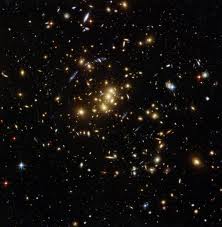 There are lots of short-lived acceleration vectors of mean magnitude that are randomly located in a quantum vacuum. The vectors in alignment with the frame look smaller while the vectors going against the frame look larger when the vacuum is viewed in an accelerated frame. This results in a net polarization within the vacuum. However, the result is linear if the acceleration (g) of the frame is slower. The coefficient of the polarization is constant if the vacuum is full of vectors. The normal exponential term for inhibiting high-energy fluctuations must also be assigned, thus, the vacuum polarization equals g/a. When multiplied by the dipole moment, the terms in the exponent result in dimensions of power. The rest frame is accelerated with respect to nearby inertial frames that fall into the center. In this rest frame The vacuum is polarized and increases the galaxy’s gravitational field. The following equation indicates the process.
There are lots of short-lived acceleration vectors of mean magnitude that are randomly located in a quantum vacuum. The vectors in alignment with the frame look smaller while the vectors going against the frame look larger when the vacuum is viewed in an accelerated frame. This results in a net polarization within the vacuum. However, the result is linear if the acceleration (g) of the frame is slower. The coefficient of the polarization is constant if the vacuum is full of vectors. The normal exponential term for inhibiting high-energy fluctuations must also be assigned, thus, the vacuum polarization equals g/a. When multiplied by the dipole moment, the terms in the exponent result in dimensions of power. The rest frame is accelerated with respect to nearby inertial frames that fall into the center. In this rest frame The vacuum is polarized and increases the galaxy’s gravitational field. The following equation indicates the process.
g= -GM/r2 + g exp (g/a)
For the preceding equation, g is recognized to be negative. The exponential is insignificant and we experience Newton’s Law when g is much greater than a. However, the exponential might be expanded to 1 + g/a when g is less than a. Thus, we get the following equation.
g2 = aGM/r2
This formula describes the motion of stars and galaxies within the weak-field area. This is the exact same formula founded by Milgrom. However, the law of gravity is modified and not the law of motion. A is found to be about one Angstrom per second squared. This is similar to the gravity on the surface of an electron. It is also in relation to the field of a single kilogram mass at a particular meter or the field of a galaxy within its outer parts. Additionally, the square of it will not be far from the worth of the cosmological continual where units result in c=1. Regarding this model, a could be viewed because of the saturated field strength in the quantum vacuum. The observations might be adequately explained by assuming a plausible quantity of ordinary matter and making use of the correct quantum law of gravity. Thus, dark matter is not needed.
The resulting apparent polarization would increase the acceleration and indeed might be the reason for the acceleration as space accelerates away from us. The event is likely due to a disturbance some time ago. The exact same method would improve if space is collapsing in a remote area. So the cosmos may possibly consist of various dispersed regions of expansion and collapse. A significant “bang” will result as virtual particles are ripped out of the vacuum when expansion becomes extreme. Where matter is crushed back into the vacuum, a collapsing area would result in a “big crunch.” The entire method is presumably infinite and eternal.